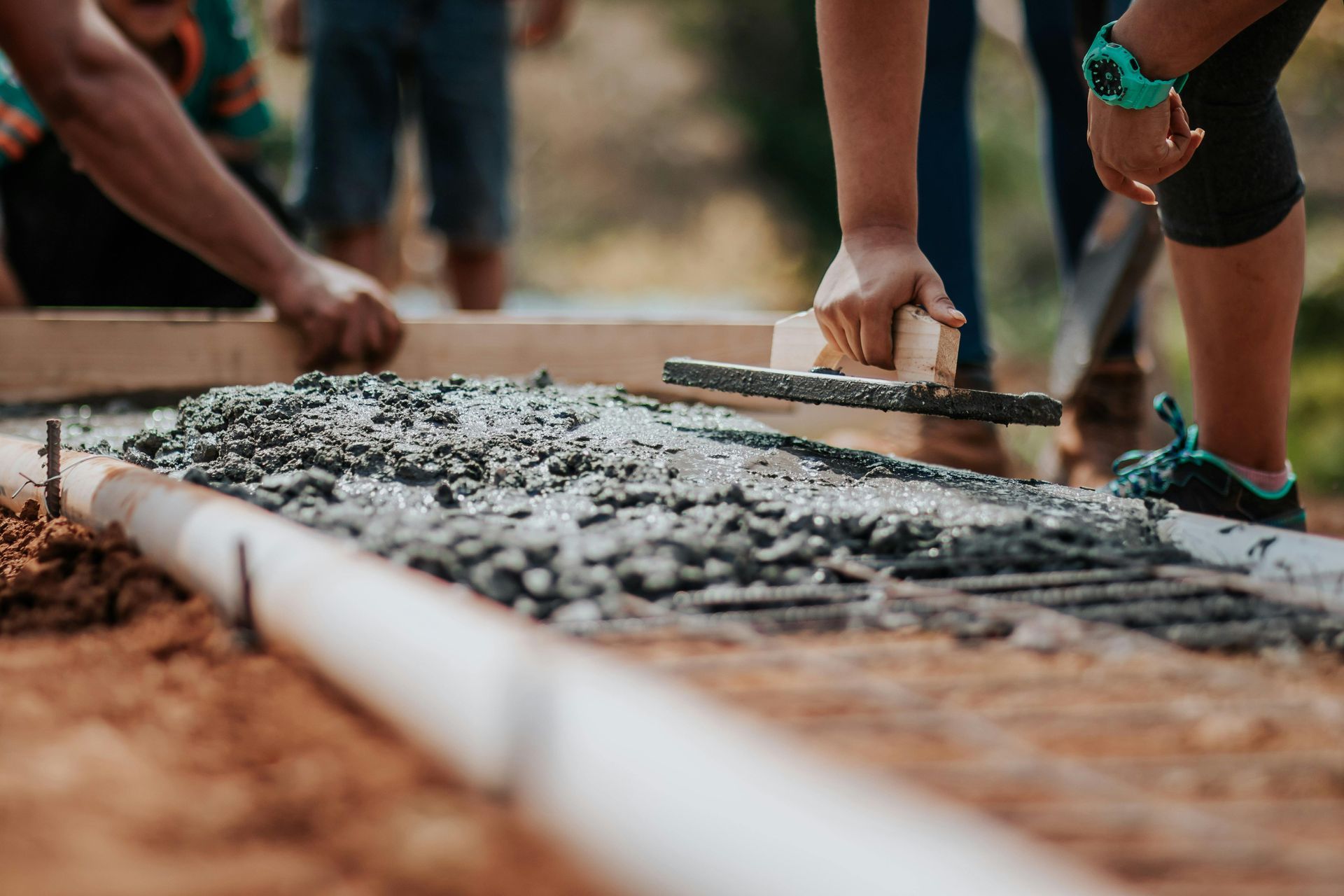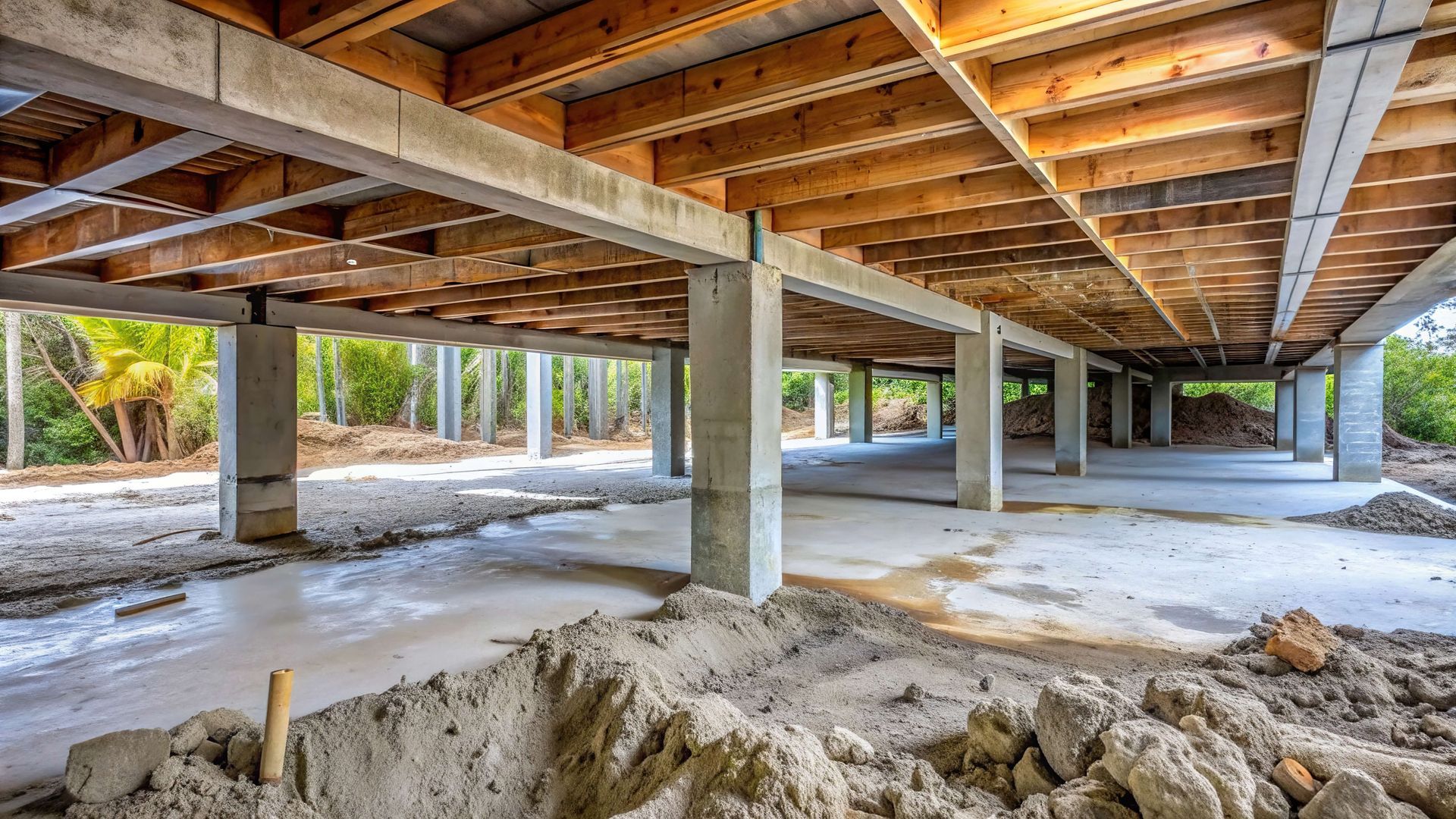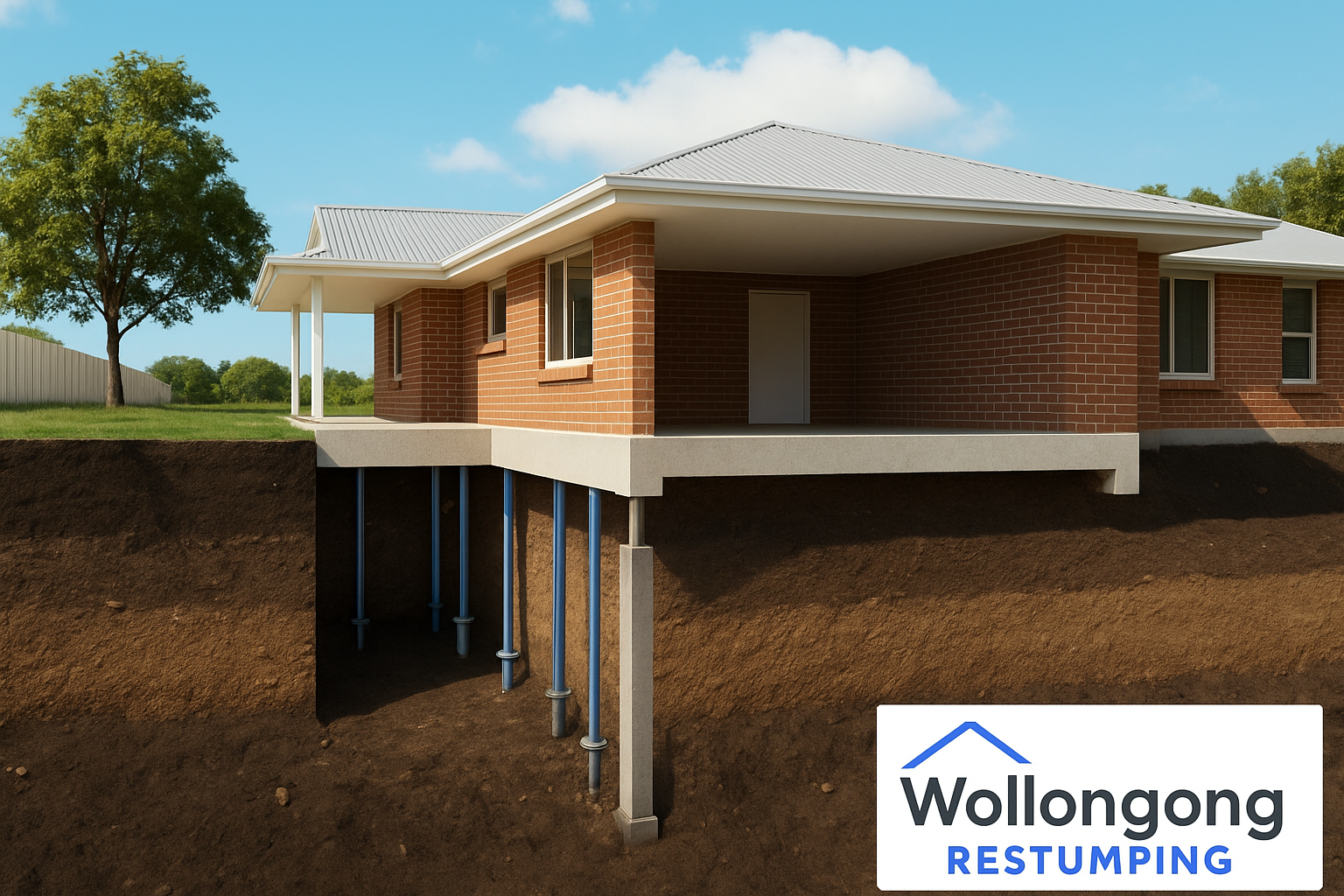wollongongrestumping@gmail.com
Concrete Piers vs Screw Piles for Home Foundation Repairs

Foundation problems can be scary and hard on the pocket. You see cracks in your walls. Your floors feel uneven. Doors won't close properly.
These are just early problems. They signal serious issues with your home's support system. And fixing them matters more than looks. You are protecting your biggest investment and keeping your family safe.
This guide explains two main ways to fix foundation problems: concrete piers and screw piles. You will learn how each method works. What makes them effective? And how to choose the right one for your home.
Understanding Foundation Repair Needs
Your home's foundation is its support system. But when the soil underneath moves, this support can weaken, leading to foundation problems. You might see warning signs like cracks in your walls, floors that feel uneven, or doors and windows that stick. It's clearly important to address these issues promptly, as ignoring them can result in more serious and costly damage later on.
Fixing your foundation is not a one size fits all job. The best approach for your home will depend on several factors, including your soil types, the extent of the damage, and your local climate. Choosing the right repair method ensures your home remains safe and stable for years to come. A poor choice, however, could lead to further repairs, extra costs, and unnecessary stress in the near future.
That's why it's so important to understand your options, such as concrete piers and screw piles to make the best decision for your property.
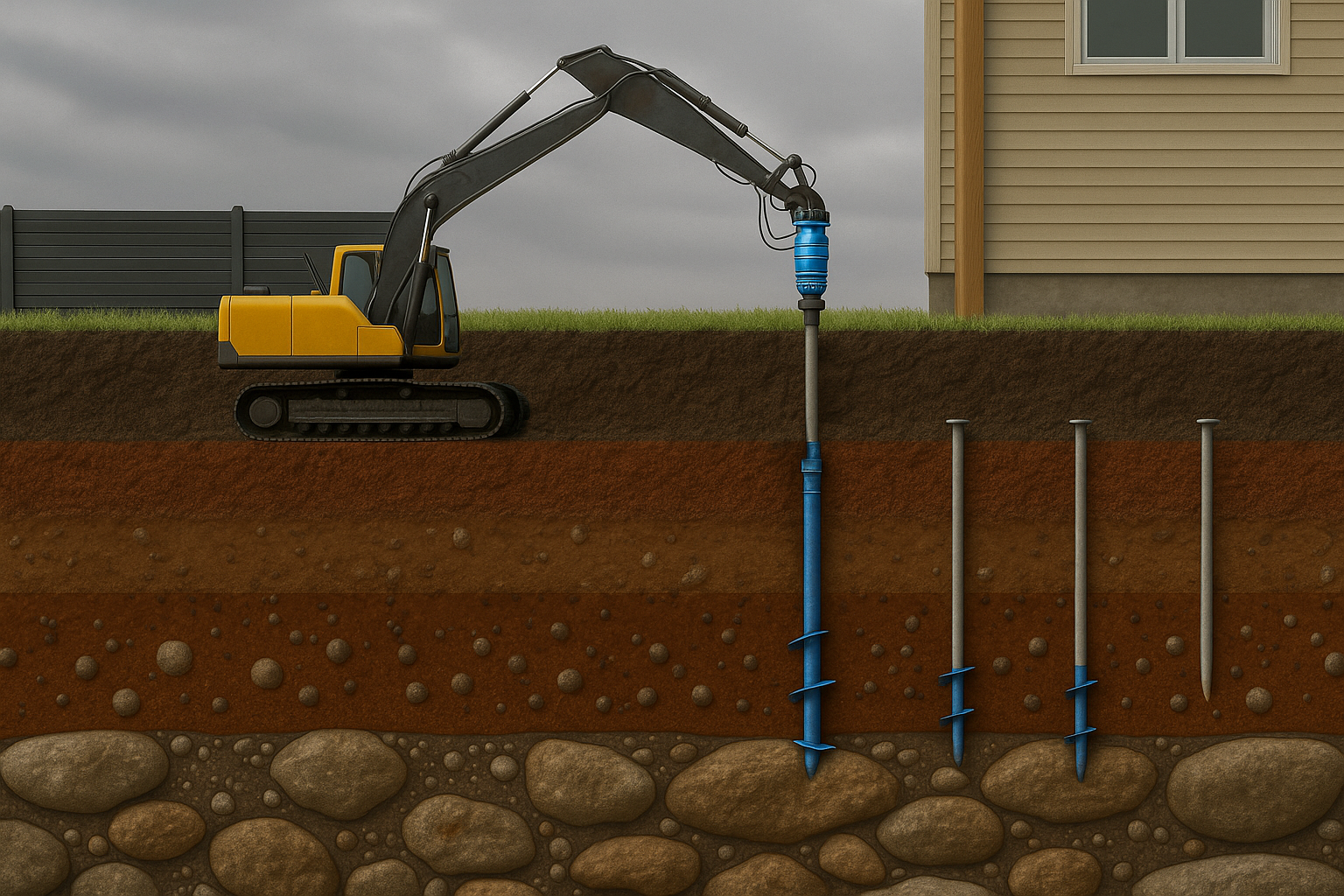
What are Screw Piles (Helical Piles)?
Screw piles, also known as helical piers. These are like giant screws that are twisted into the ground to support your home's foundation. They are made of steel and have helix-shaped plates, similar to a screw thread, that help them go deep into the soil. Once they reach stable ground, they are connected to your home's deep foundation, providing strong and reliable support.
Installation Process of Screw Piers
The screw piling is a straightforward process. A specialized machine twists the steel piles into the ground, much like screwing a bolt into wood. The process is quiet and creates very little mess with high installation speed. The piles are driven until they reach a certain depth and resistance, ensuring they are properly anchored in the ground. Once in place, a bracket is attached to the top of the pile, and this bracket is then connected to your home's existing foundation to support load capacity. The weight of your house is then transferred to the screw piles, which are supported by the deeper, stronger soil.
Helical Piers Application and Suitability
Screw piles are a good choice for many different types of foundation problems. They work well in various soil conditions, including soft, unstable or reactive soils because they can be extended to reach deeper, more stable layers. They are also a good option for homes that need quick repairs, as their installation is much faster than traditional methods and provides long-term durability. Because they cause minimal disruption, they are also preferred for homes in established neighborhoods or in suburbs like Dapto, Wollongong, where landscaping needs to be preserved.
Advantages of Screw Piles
Screw piles offer several benefits that make them a popular choice for foundation issues:
- Quick Installation: One of the biggest advantages of screw piles is how fast they can be installed. Unlike concrete curing, which needs time to dry and harden, screw piles can be put in place and start supporting your home within days. This means less waiting around and a quicker return to normal for you and your family.
- Little Mess and Disruption: The installation process for screw piles creates very little mess. There's no need for large excavations or heavy machinery, which means less dirt and debris around your home. It's great for keeping your yard and landscaping intact, and it reduces the maintenance costs of your house.
- Immediate Support: As soon as screw piles are installed, they are ready to bear the weight of your home. There's no waiting for concrete to cure, which means your foundation can be stabilized right away with no project delays.
- Works in Any Weather: Screw piles can be installed in almost any weather condition. Cold or Wet weather, which can delay concrete projects, usually doesn't stop screw pile installation.
- Good for the Environment: Because screw piles require less digging, they cause less ground disturbance to the surrounding environment. Means less waste material to remove from your property.
Disadvantages of Screw Piles
While screw piles have many benefits, there are a few things to consider:
- Cost: The initial cost of installing screw piles can sometimes be higher than traditional concrete piers. However, when you consider the faster installation time, less disruption, and immediate load-bearing capacity, the overall value can be greater.
- Newer Technology: Compared to concrete piers, which have been around for a very long time, screw piles are a newer technology and specialized equipment. While they have a proven track record of success, some people might prefer the more established method.
- Heavy Structures: For extremely heavy structures, concrete piers might be a more suitable option due to their inherent mass and rigidity. However, for most residential homes, screw piles are more than capable of providing the necessary support.

What are Concrete Piers?
Concrete piers, also known as bored piers, are a traditional method of
foundation repair. They involve digging deep holes into the ground and filling them with concrete to create solid columns of support for your home. These piers extend down to stable soil layers, providing a strong and durable base for your foundation.
Concrete Foundations Application and Uses
Concrete piers have been used for a long time to fix foundation problems. They are a common choice for homes where the soil near the surface is weak or unstable, and a deep, rigid support is needed. They are particularly useful for supporting very heavy structures or in situations where a large, unmoving base is required. Many engineers have traditionally recommended concrete piers as a standard solution for foundation repair due to their proven strength and reliability over many years.
Advantages of Concrete Piers
Concrete piers offer several benefits that have made them a long-standing choice for foundation repair:
- Strength and Durability: Concrete is known for its strength and ability to last a long time. Once concrete piers are installed and cured, they provide a very strong and stable support for your home. They are designed to handle heavy loads and resist movement, giving your foundation a solid base.
- Proven Track Record: Concrete piers have been used for many years in construction and foundation repair. This long history means there is a lot of experience and data showing their effectiveness and reliability. Many builders and engineers are familiar with this method, and it is a well-understood solution.
- Cost-Effectiveness for Specific Uses: In some situations, especially for certain types of soil or specific foundation problems, concrete piers can be a cost-effective solution. The materials are generally less expensive than steel screw piles, and for straightforward repairs, they can be a good economic choice.
Disadvantages of Concrete Piers
Despite their benefits, concrete piers also come with some drawbacks:
- Longer Installation Time: Concrete needs time to set and cure, which can take one to two weeks. Means the overall repair project will take longer, causing more inconvenience for homeowners. Delays can also happen due to bad weather, like rain, which can stop work or even damage freshly poured concrete footings.
- Significant Site Disruption: Installing concrete piers involves a lot of digging. This creates a lot of mess and spoil (excavated dirt) that needs to be managed. Large piles of dirt can be inconvenient and even unsafe if not handled properly. The extensive digging can also damage your yard or even the underground sewerage and plumbing pipes.
- Weather Dependency: Concrete work is very sensitive to weather. Rain can wash away fresh concrete or make the ground too muddy to work, leading to significant delays. Extreme temperatures can also affect the curing process, impacting the strength and quality of the piers.
- Quality Concerns: The quality of concrete piers depends a lot on the skill of the workers and how well the site is managed. If the concrete is not mixed right, or if there isn't enough steel reinforcement, the piers might not be as strong as they should be. Poor workmanship can lead to problems like damaged surrounding concrete or issues with the pier itself, which can mean more repairs later.
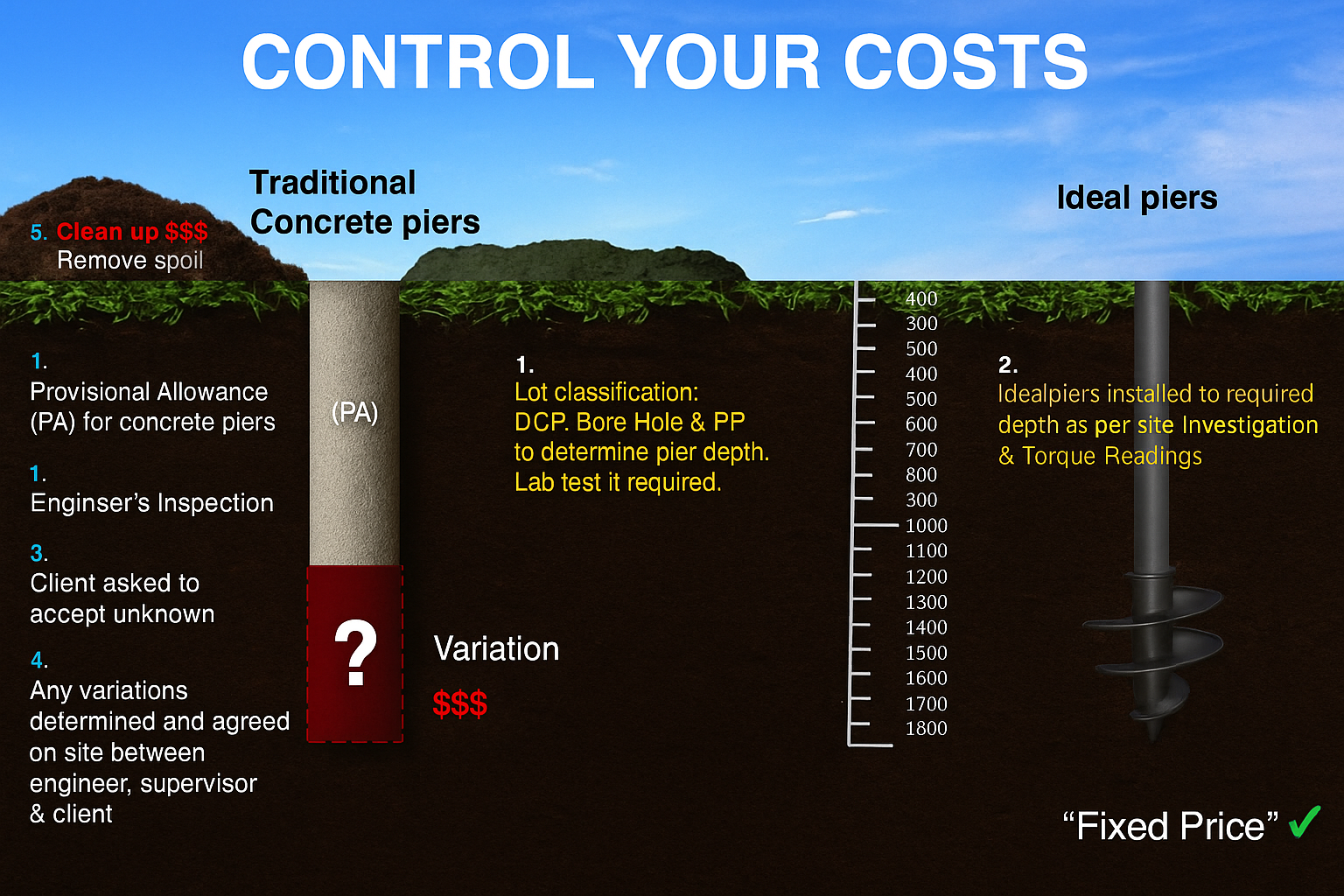
Cost Comparison What to Expect
When you are thinking about foundation repair, the cost is always a big part of the decision. It is important to look at both the initial cost and what you might pay over time.
Initial Costs of Installation
For concrete piers, the initial cost can sometimes be lower than screw piles. Because the materials (cement and rebar) are generally less expensive. However, you also need to think about the cost of digging, labour, removing a lot of dirt, and the longer time it takes for the concrete to dry. These things can add to the overall price.
Screw piles, on the other hand, might have a higher upfront cost for the materials themselves. But, because they are installed much faster and create less mess, you can save money on labor and site cleanup. There is also less chance of delays due to weather, which can save you money by keeping the project on schedule with long-term stability.
Long-Term Maintenance Expenses
Both concrete piers and screw piles are designed to be long-lasting solutions. If installed correctly, neither should need a lot of maintenance. However, with concrete, there is a small chance of issues if the curing process was not perfect or if there were problems with the mix. These issues could lead to future repairs. Screw piles, being steel, are resistant to many environmental factors and are designed for a very long life once installed.
Environmental Considerations
Thinking about the environment is becoming more and more important, even when it comes to home repairs. Both concrete piers and screw piles have different impacts on the environment.
Impact on Surrounding Environment During Installation
Concrete pier installation involves a lot of digging. It means a significant amount of soil is removed from the ground, which then needs to be transported and disposed of. This process can disturb the local ecosystem, and the transportation of heavy materials and excavated soil contributes to carbon emissions. The use of water for mixing concrete also needs to be considered.
Screw pile installation is much less invasive. Because they are screwed into the ground, there is very little digging and almost no soil removal. Means less disruption to your yard and the surrounding environment. The machinery used for installation is also generally smaller and produces less noise and emissions compared to the heavy equipment needed for concrete work.
Sustainability of Materials Used
Concrete is a widely used building material, but its production, particularly cement, is known to be energy-intensive and a significant source of carbon dioxide emissions. While concrete is durable, its environmental footprint during manufacturing is something to consider.
Screw piles are made of galvanized steel helix plates, which are a recyclable material.
The manufacturing process for steel also has environmental impacts, but the ability to recycle the material at the end of its life can make it a more sustainable choice in the long run. Additionally, because screw piles can be removed and reused in some cases, they offer a level of reusability that concrete does not.
Case Studies of Successful Applications
Looking at real-world case studies can help you see how both concrete piers and screw piles have been used to solve foundation problems. While the specific details of each project vary, these examples show the effectiveness of each method.
Notable Screw Pile Installations
Companies that specialize in screw pile solutions often highlight projects where their systems, like the steel anchoring system combined with
Wollongong Restumping's screw piles, have provided quick and clean repairs. These case studies emphasize how screw piles were installed with minimal debris, even in challenging weather, and provided immediate support to homes. They showcase how this modern approach can be a great fit for homeowners looking for a fast and efficient repair with less mess.
Notable Concrete Pier Installations
For concrete piers, case studies focus on projects where their structural support, strength and durability were key. These examples might include very large or heavy structures that need a robust, long-lasting foundation. They demonstrate how cured concrete, with its proven history, can provide a solid and unmoving base, especially when dealing with specific soil conditions like deep sandy terrain that benefit from a more traditional, heavy-duty approach. While concrete installation takes longer and causes more disruption, these case studies show that for certain situations, it remains a reliable choice.
Making Your Decision
Choosing between concrete piers and screw piles for your home's foundation repair is a significant decision. Both methods offer effective solutions, but they come with different advantages and considerations regarding installation time, site disruption, cost, and environmental impact. Concrete piers, with their long history, provide robust support, while modern screw piles offer faster, cleaner installation with less impact on your property. The best choice for your home will depend on its specific needs, the soil conditions, and your priorities.
Ultimately, the goal is to secure your home's foundation for the long term. Take the time to understand each option, consider what matters most to you, and consult with experienced professionals at no cost.
Frequently Asked Questions
Are screw piers better than concrete piers?
Not always. Screw piers install faster, work in most weather, and start supporting right away. Concrete piers are stronger for very heavy buildings and can be more affordable. The best choice depends on your soil, damage, and budget.
When should I use piers vs piles?
Piers are usually bigger, made of concrete, and built on-site. Piles (like screw piles) are pre-made big iron screws and screwed into the ground. Both are used when shallow soil isn’t strong enough. The choice depends on soil type, load needs, and access to the site.
Are ground screws better than concrete piles?
Ground screws (screw piles) are quicker, cleaner, and less weather-dependent. Concrete piles are tougher for very heavy loads but take longer to install. It depends on the project size and soil.
What’s the difference between a screw pile and a concrete pile?
Screw pile: Steel shaft with screw-like plates, twisted into the ground. Great for quick installs and lighter loads.
Concrete pile: Precast or poured on-site. Stronger for heavy structures but slower and more disruptive to install.
How do I know if my home needs foundation repair?
Watch for cracks in walls, uneven floors, doors or windows sticking, gaps around frames, or parts of the house sinking. If you see these signs, call a foundation repair expert.
Ready to work with Wollongong Restumping?
Let's connect! We’re here to help.
Send us a message and we’ll be in touch.
Or give us a call today at 0242026325



